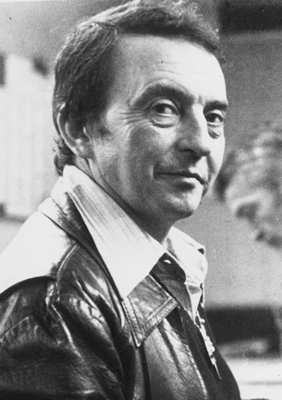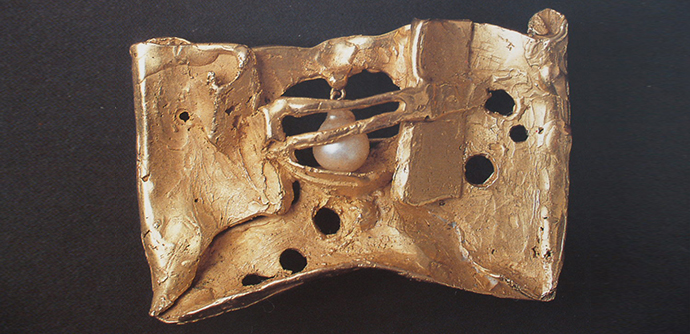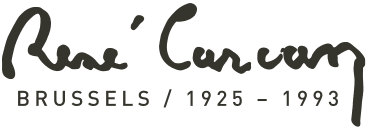Biography
René Carcan
Brussels, February 25, 1925 – January 19, 1993

A Belgian printmaker and watercolourist.
He originally studied sculpture at the Academy of Saint-Josse-Ten-Noode under Gustave Jacobs, then, from 1941 to 1946, he studied painting at the Academy of Brussels under Jacques Maes and Léon Devos.
He started showing his drawings in Brussels in 1952. Having received a grant from UNESCO, he left for Italy, from Florence to Rome, where he was fascinated by the universe of the Etruscans, and more particularly by the chromatics and the dancing rhythm of their funerary frescoes. From then on, Tuscany and Etruria became one of his main sources of inspiration. Back in Brussels, at the instigation of his friend, the historian and poet, Philippe Roberts-Jones, he decided to turn his hand to printmaking. From 1960 to 1965, he worked in the Parisian studio of Johnny Friedländer, who taught him the techniques of colour etching. In 1963, he was a founding member of the group Cap d’Encre, along with seasoned printmakers such as Pierre Alechinsky, Gabriel Belgeonne, Francis De Bolle, Lismonde, Marc Laffineur and Gustave Marchoul. Cap d’Encre produced five Portfolios up to 1970.
At this time also, his renown as an etcher had already spread far beyond our borders, as he exhibited his work in Paris, in the USA, in Tokyo, in Ljubljana and in Krakow. Leaving the city in the late 60’s, he bought a small farmhouse in Huldenberg, in Flemish Brabant, where he went to recharge his batteries at the weekend, focussing his art towards dreamlike, imagined landscapes, half Tuscan, half Breughelian, where the tree became a powerful king courted by his vassals, the sunflowers and thistles. In Carcan, the four elements of nature found a new symbolic interpretation in which man sometimes made a timid appearance, as if afraid to disturb this sublime Edenic harmony. This incisive designer was also a daring colourist, favouring sun-warmed reds and oranges, sometimes sprayed with a spurt of lemon yellow, while loving water greens, azure blues and of course the earth tones of Sienna ; warm colours to glorify a fruitful nature bathed successively in a spring or summer light. A skilled printmaker – he was able to engrave directly onto a copper plate – he was also extremely productive since his two 'catalogues raisonnés' included slightly over 800 prints. He was a polymorphic artist, always eager to experiment. He was equally happy to turn his hand to sculpture and jewellery and he also became the recognised illustrator of poet friends like André Sempoux, Jean Orizet and Philippe Roberts-Jones.

The decade of the 70’s was one of the most prolific of his carreer, when he exhibited his prints all over the world : United States, Canada, Australia, South Korea, Germany, Norway, Sweden, the Netherlands, Italy, France and the Grand Duchy of Luxembourg.
At the beginning of the 80’s, he literally conquered West Germany, holding several successful exhibitions in more than twenty of the main cities. At the end of the 80’s, as he was getting older – he was soon going to be 65 – and since he had no heirs, he thought about perpetuating his artistic heritage. And this is how on January 1, 1990 the non-profit association 'asbl Fondation René Carcan' was created in his studio at 122-124 Avenue Champ du Roi in Etterbeek. The main aim of the association was to « develop the art of printmaking » and « for this purpose, the association also plans to organise training courses, exhibitions and in general to promote edition and publication work relating to printmaking». As a result, each year the studio became a welcome centre for two international students of printmaking, the end of the academic year being crowned by a personal exhibition of their works. Henceforward the Foundation was divided – between the two adjoining houses - into a studio-space and an exhibition-space. The latter welcomed the biggest names in printmaking of the 20th century. Giving honour where honour is due, it was his old mentor, Johnny Friedländer, who opened the Fondation René Carcan in person on October 20, 1989, followed – amongst others – by the Brazilian, Arthur Piza, the Israeli, Tuvia Beeri and also the Japanese, Hasegawa, the Spaniard, Antoni Clavé (1991), the Austrian, Hundertwasser (1992), the Italian, Avati (1992) and the German, Horst Janssen (1993).
René Carcan died at the beginning of 1993 and his German gallery owner, Ricardo De Bernardi, became the sole legatee of the association. The Fondation Carcan survived somehow, but without René, the heart was no longer in it. We should still mention the exhibition in 2001 of the works of Lise Brachet who had been one of his pupils, in 2002, the exhibition of the Peruvian, Antonio Mãro, the Germans, Gerhard Hofmann and Gabriel Belgeonne in 2003 and the Brussels group, Raskas in 2005. Running out of steam, the association finally ceased its activities in 2006, losing its title of 'Fondation' and becoming the 'Espace René Carcan'. In 2013, in partnership with the Fondation Roi Baudouin, the asbl René Carcan decided to work on the creation of the 'René Carcan International Prize for Printmaking', thus fulfilling what had always been one of the great wishes of the artist, 20 years after his death.
René Carcan’s works are part of many public collections, including the Musées Royaux des Beaux-Arts in Brussels, the Musée communal d’Ixelles, the Bibliothèque Royale de Belgique in Brussels, the Centre de la Gravure et de l’Image imprimée in La Louvière, the Cabinet des Estampes et des dessins in Liege, the Musée de l’UCL (Donation Serge Goyens de Heusch) in Louvain-la-Neuve, the Musée Royal de Mariemont and the Bibliothèque Nationale de France in Paris.
